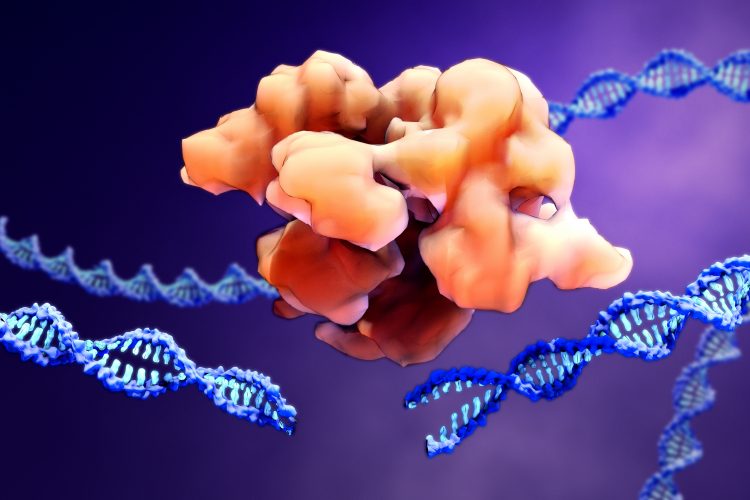CRISPR-Cas9-based gene dropout screens: a powerful platform for drug discovery
Posted: 23 September 2021 | Dr Pushpanathan Muthuirulan (Harvard University) | No comments yet
CRISPR holds great promise in advancing pharmacological research and has fuelled the rapid expansion of using gene-edited cells for drug discovery processes. CRISPR-Cas9 dropout screens have emerged as a useful tool for high-throughput large-scale loss-of-function screens, which seek to identify the relationship between genotype and phenotype. Dr Pushpanathan Muthuirulan, Research Associate at Harvard University, explores why researchers will adopt this CRISPR technology to address some of the pressing unanswered questions related to disease pathobiology and how it will aid the development of new drugs.


Uncovering the links between genes and their biological functions helps researchers to understand disease biology and develop new drugs or improve existing drugs to stop/reverse the effects of diseases. Many drugs are discovered and tested every year to find potential beneficial effects against numerous diseases. At the early stage of drug discovery, thousands of compounds are considered as potential candidates for development as medical treatments; however, after early testing and functional validation, only a small fraction of compounds are suitable for further study. As a result, the process of researching and developing new drugs with advantageous effects to treat diseases in human subjects is continuously expanding in difficulty and time.1
On average, it takes at least 10-12 years for a new drug to complete the development journey and reach the marketplace, with clinical trials alone taking six to seven years on average. The mean cost of developing a drug has been the subject of debate, with recent estimates ranging from $314 million to $2.8 billion. This figure includes the cost of failures – although thousands of drugs may be screened and validated early in the R&D process, only a few of which go on to receive approval. The overall probability of a new drug entering clinical trials and eventually being approved is estimated to be less than 12 percent. Thus, the drug discovery process is a highly complex, lengthy and costly one, associated with a high degree of uncertainty that a drug will succeed.2
The overall probability of a new drug entering clinical trials and eventually being approved is estimated to be less than 12 percent”
At the same time, the emergence of drug resistance has accelerated, giving rise to life-threatening diseases that will not respond to existing drug treatments, meaning patients will continue to need novel drugs and therapies.3 To overcome these obstacles, new powerful technologies and guidelines for the drug discovery process should be generated, which would provide scientists in industry and academia with a foundation to support the discovery of drugs or improve existing drugs over a sustained period.
The long-anticipated recognition of the ground-breaking discovery of gene-editing tool CRISPR, which was awarded the Nobel Prize in Chemistry in 2020, has elated the scientific community. Since its breakthrough development in 2012, CRISPR has revolutionised many aspects of our daily lives and transformed our ability to precisely manipulate genetic material and generate testable hypotheses.4 CRISPR-Cas9 targeted genome editing techniques offer powerful tools for studying disease biology and have greatly contributed to advances in biomedical science.4 Many researchers worldwide have adopted this game-changing technique to study the functions of different genes and treat genetic illness, ranging from sickle cell disease to blood cancers and rare genetic disorders of the eyes.5 CRISPR has raised hope that direct manipulation of the genome could potentially transform the process of drug and therapeutic discovery. In particular, CRISPR-Cas9 technology is a key to unlock novel drug targets and serves as a promising tool for discovering potential approaches to overcome drug resistance.
CRISPR has gained popularity within the scientific community and become an indispensable tool for biological research. The technique is far cheaper, faster and more efficient than other gene editing methods. CRISPR technology enables a huge range of alterations to be made in genomes, including gene knockouts, knock-ins, generation of specific insertion or mutations and the ability to activate or repress gene functions. These changes, coupled with physiological relevance, make this technology more likely to have a tremendous impact across the entire breadth of the drug discovery process.4
CRISPR has also now become a simple and efficient tool for generating targeted loss of function (LOF) mutations”
CRISPR has also now become a simple and efficient tool for generating targeted loss of function (LOF) mutations.6 Previously, genome-wide screens were conducted using RNA interference (RNAi) technology, which is in the form of short interfering RNA (siRNA) or short hairpin RNA (shRNA) libraries.7 Such screens have made significant contributions to the field of genomics; however, their success has been limited by the varying efficiencies of siRNAs/shRNAs to silence target genes required for genome-wide studies. In general, RNAi technology produces high off-target effects which cause issues with false-positive results. Furthermore, RNAi technology works by reducing gene expression at the post-transcriptional level by targeting RNA transcripts, meaning RNAi-based screens only result in the partial and short-term suppression of genes. CRISPR-Cas9-based approaches are expected to overcome such limitations and are now becoming a popular choice for administering large-scale pooled screens.8
In recent years, CRISPR-Cas9-based gene dropout screens have been used to probe the mechanics of model systems. In a genome-wide CRISPR screening platform, the endonuclease Cas9 and a pooled guide RNA library were used in combination, which allows for high-throughput systematic screenings of genes associated with a growth disadvantage or lethal phenotype under various conditions in organisms and tissues. Performing such genome-wide CRISPR-Cas9 LOF screens in relevant cell types under pharmacological pressure with different drugs would help to identify targets whose inhibition will enhance biological activity (eg, antitumour activity). The genes identified by CRISPR screens whose ‘dropout’ associates with increased sensitivity to specific drug treatment serve as a basis for selecting potential candidate targets for combination treatment with that drug. For example, Gilad et al, have performed a genome-scale CRISPR-Cas9 screen in MCF-7 breast cancer cells under conditions of pharmacological pressure with the steroid receptor coactivator 3 (SRC-3) small molecule inhibitor SI-12.
From this screen, they identified eight candidates for which small molecular inhibitors are commercially available and subsequently validated all these targets for their co-operative anticancer activity in the presence of SI-12 by targeted functional genomics and drug combination experiments. By extending the drug-gene vulnerabilities evaluation beyond the MCF-7 cell line, these researchers also discovered highly potent cancer-killing combinations of SI-12 in pancreatic, prostate and triple-negative breast cancer (TNBC) cells with DNMT and RhoA inhibitors.9 In another study, Tzelepis et al, used a CRISPR dropout screen and identified genetic vulnerabilities and therapeutic targets (DOT1L, BCL2, MEN1and many other genes) in acute myeloid leukaemia (AML).10
Over recent years, genome-wide CRISPR screens have been used by many researchers and are considered highly useful for studying the intricate networks of cellular signalling11 and identifying synthetic lethal partners.12 It is also used as a screening strategy for host dependency factors (HDFs) in viral infections.13 Other applications of genome-wide CRISPR screens include the study of mitochondrial metabolism,14 novel genetic drivers of metastatic progression15 and drug resistance in cancer,16 West Nile virus-induced cell death17 and networks of gene expression in immune cells.18 In recent years, researchers have aimed to combine genome-wide CRISPR screening with single-cell RNA-sequencing (RNA-seq). Studies utilising CRISP-seq,19 CROP-seq20 and PERTURB-seq21 have successfully identified gene expression signatures for individual gene knockouts in a complex pool of cells. These methods have the added benefit of producing sgRNA-induced transcriptional profiles in target cell populations.
In summary, the recent emergence of CRISPR-Cas9 technology has tremendously increased our ability to perform large-scale LOF screens. The high versatility and programmability of Cas9 endonuclease, coupled with high knockout efficiency and low off-target effects, have made CRISPR a promising platform for many researchers engaging in gene targeting and editing. Furthermore, the establishment of CRISPR systems as a feasible high-throughput gene-editing technology has opened new horizons in drug discovery, dramatically increasing our ability to explore gene-drug interactions and reveal novel drugs or drug targets for the treatment of human diseases.
About the author
Dr Pushpanathan Muthuirulan is currently a Research Associate at Harvard University studying the developmental and genetic basis of human height variations using functional genomics approaches. Previously, he worked as a Postdoctoral Researcher at the National Institutes of Health, where his research focused on developing state-of-the-art technologies using CRISPR-Cas9 and super-resolution microscopy to map neural circuits that involves visual motion information processing in Drosophila. His expertise lies in omics technologies, drug discovery, neuroscience and developmental and evolutionary genetics.
References
- Mohs RC, Greig NH. Drug discovery and development: Role of basic biological research. Alzheimer’s & Dementia: Translational Research & Clinical Interventions. 2017 Nov 1;3(4):651-7.
- Wouters OJ, McKee M, Luyten J. Estimated research and development investment needed to bring a new medicine to market, 2009-2018. Jama. 2020 Mar 3;323(9):844-53.
- Vasan N, Baselga J, Hyman DM. A view on drug resistance in cancer. Nature. 2019 Nov;575(7782):299-309.
- Muthuirulan P. CRISPR: a molecular scissor set to change the world. Drug Target Review. 2019 Dec Issue 4.
- Muthuirulan P. CRISPR: kick-starting the revolution in drug discovery. Drug Target Review. 2019 Nov (Issue 4):19-22.
- Zhou Y, Zhu S, Cai C, et al. High-throughput screening of a CRISPR/Cas9 library for functional genomics in human cells. 2014 May;509(7501):487-91.
- Zuber J, Shi J, Wang E, et al. RNAi screen identifies Brd4 as a therapeutic target in acute myeloid leukaemia. Nature. 2011 Oct;478(7370):524-8.
- Boutros M, Ahringer J. The art and design of genetic screens: RNA interference. Nature Reviews Genetics. 2008 Jul;9(7):554-66.
- Gilad Y, Eliaz Y, Yu Y, et al. A genome-scale CRISPR Cas9 dropout screen identifies synthetically lethal targets in SRC-3 inhibited cancer cells. Communications Biology. 2021 Mar 25;4(1):1-7.
- Tzelepis K, Koike-Yusa H, De Braekeleer E, et al. A CRISPR dropout screen identifies genetic vulnerabilities and therapeutic targets in acute myeloid leukemia. Cell Reports. 2016 Oct 18;17(4):1193-205.
- Sharma S, Petsalaki E. Application of CRISPR-Cas9 based genome-wide screening approaches to study cellular signalling mechanisms. International Journal of Molecular Sciences. 2018 Apr;19(4):933.
- Wang C, Wang G, Feng X, et al. Genome-wide CRISPR screens reveal synthetic lethality of RNASEH2 deficiency and ATR inhibition. Oncogene. 2019 Apr;38(14):2451-63.
- Li B, Clohisey SM, Chia BS, et al. Genome-wide CRISPR screen identifies host dependency factors for influenza A virus infection. Nature Communications. 2020 Jan 9;11(1):1-8.
- Birsoy K, Wang T, Chen WW, et al. An essential role of the mitochondrial electron transport chain in cell proliferation is to enable aspartate synthesis. Cell. 2015 Jul 30;162(3):540-51.
- Chen S, Sanjana NE, Zheng K, et al. Genome-wide CRISPR screen in a mouse model of tumor growth and metastasis. 2015 Mar 12;160(6):1246-60.
- Shi J, Wang E, Milazzo JP, et al. Discovery of cancer drug targets by CRISPR-Cas9 screening of protein domains. Nature Biotechnology. 2015 Jun;33(6):661-7.
- Ma H, Dang Y, Wu Y, et al. A CRISPR-based screen identifies genes essential for West-Nile-virus-induced cell death. Cell Reports. 2015 Jul 28;12(4):673-83.
- Schmid-Burgk JL, Chauhan D, Schmidt T, et al. A genome-wide CRISPR (clustered regularly interspaced short palindromic repeats) screen identifies NEK7 as an essential component of NLRP3 inflammasome activation. Journal of Biological Chemistry. 2016 Jan 1;291(1):103-9.
- Jaitin DA, Weiner A, Yofe I, et al. Dissecting immune circuits by linking CRISPR-pooled screens with single-cell RNA-seq. Cell. 2016 Dec 15;167(7):1883-96.
- Datlinger P, Rendeiro AF, Schmidl C, et al. Pooled CRISPR screening with single-cell transcriptome readout. Nature Methods. 2017 Mar;14(3):297-301.
- Dixit A, Parnas O, Li B, et al. Perturb-Seq: dissecting molecular circuits with scalable single-cell RNA profiling of pooled genetic screens. Cell. 2016 Dec 15;167(7):1853-66.
Related topics
CRISPR, DNA, Drug Targets, Gene Testing, Gene Therapy, Genetic Analysis, Genome Editing, Genomics, Molecular Targets, Protein, RNAs, Target Molecule, Targets, Technology
Related conditions
Breast cancer, Pancreatic cancer
Related organisations
GenScript, Harvard University, The National Institutes of Health, Thermo Fisher Scientific








